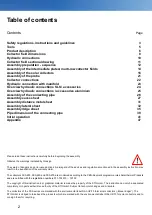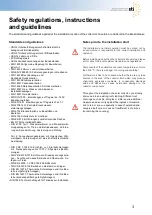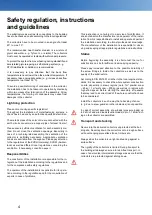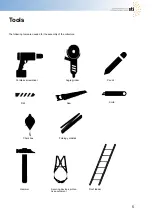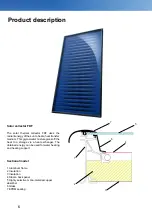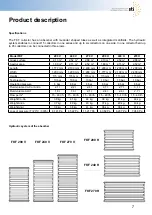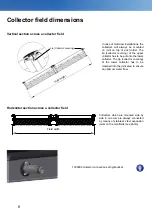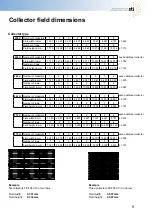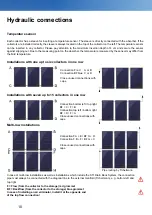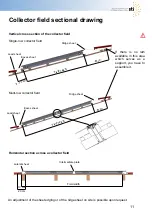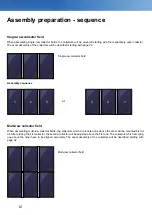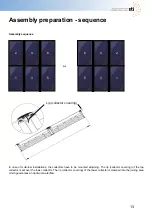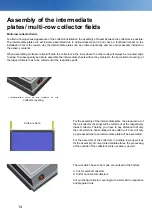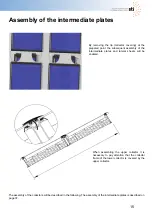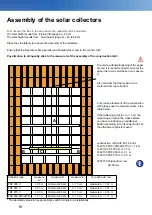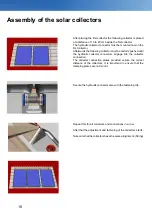
4
Safety regulation, instructions
and guidelines
The substructure as well as its connections to the building
have to be checked on site according to the local regulations.
The collectors have to be mounted in an angle of at least
20° to max. 70°.
The recommended heat transfer medium is a mixture of
glycol and water, e. g. Tyfocor L or similar. The collectors
must never be operated or tested with water under pressure.
To protect the system from overheating during standstill and
accelerated glycole-ageing, a self-draining system (e. g.
STI Drain Master or SolBox) is recommended.
It is necessary to pay attention that the back flow
temperature is never lower than the ambient temperature. If
necessary, take appropriate action (e. g. increase back flow
temperature to at least 30 °C).
To avoid a possible forming of condensate in the collector,
the installation has to be taken into operation hydraulically
within two weeks after termination of the assembly. At low
temperatures, the forming of condensate may cause frost
damages in the collector.
Lightning protection
Please note country-specific legislation!
Throughout the installation of metal fastening systems, a
check has to be done by an authorized qualified electrician.
The metallic pipes of the solar circle are connected with the
earth circuit connector via a copper pipe of at least 16 mm².
Please ensure sufficient ventilation for each assembly me
-
thod. Do not close the ventilation openings. Especially in
case of a roof-integrated assembly, the ventilation of the
collector is definitely necessary. Appropriate ventilation
hoods are available from the supplier. Please pay attention
to the regulations of the ZVDH (Germany), SVDW (Switzer
-
land) as well as different local regulations concerning the
ventilation. If necessary, consult an expert.
Responsibilities
The constructor of the installation is responsible for the in-
tegration of the installation according to the regulations and
for the compliance with safety regulations.
The operator of the installation is responsible for its opera-
tion according to the regulations and for the consultation of
experts in case of problems.
This instruction is not subject to a service of modification. It
does not absolve the manufacturer and operator of the instal-
lation from his resposibilities to install and operate all parts of
the installation according to utmost professional knowledge.
The manufacturer of the installation is responsible for obser-
ving and keeping all appropriate regulations and instructions.
Statics
Before beginning the assembly it is vital to test the roof or
substructure on site for sufficient load-carrying capacity.
Please pay increased attention to the possible durability of
the screw fittings to fasten the collectors as well as to the
quality of the substructure.
According to DIN EN 1991 or rather to the local engineer stan
-
dards, it is necessary to check the whole system construction
on site, especially in snowy regions (note: 1m³ powder snow
~ 60 kg / 1 m³ wet snow ~ 200 kg) as well as in regions with
high wind speed. Before starting the assembly, all aspects
that may lead to incorrect load of the whole construction have
to be considered!
Install the collectors in such a way that a backlog of snow
(e. g. due to snow guards or other obstacles) is not possible.
In case of correct assembly, snow loads (pressure loads) up
to 2
kN/m² and wind loads (suction loads) up to 1,1 kN/m² act
-
ing on the collector are permitted.
Transport and stocking
Never store the delivered collectors unprotected at the buil-
ding site. Never lay down the collectors onto a rough surface
with overhanging pieces like stones, timbers etc..
Always stock the collectors upright and leaning against a
solid surface.
The rigidity of the collectors is limited. During transport to
the building site always ensure a torsion-free transport. In
case of an elevated intermediate storage make sure that the
collectors are protected against sliding down.
Summary of Contents for FKF 200
Page 1: ...Assembly instructions Solar collectors FKF 200 240 270 Roof integrated installation...
Page 43: ...43 Initial operation Schematic drawing of the system construction and piping scheme...
Page 44: ...44 Initial operation Schematic drawing of the system construction and piping scheme...
Page 45: ...45 Notes Initial operation...
Page 46: ...46 Notes Initial operation...


